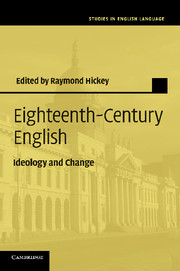Book contents
- Frontmatter
- Contents
- List of figures
- List of maps
- List of tables
- Notes on contributors
- Preface
- 1 Attitudes and concerns in eighteenth-century English
- 2 Prescriptivism and the suppression of variation
- 3 Women's grammars
- 4 Eighteenth-century women and their norms of correctness
- 5 Lowth as an icon of prescriptivism
- 6 Queeney Thrale and the teaching of English grammar
- 7 Coalitions, networks, and discourse communities in Augustan England: The Spectator and the early eighteenth-century essay
- 8 Contextualising eighteenth-century politeness: social distinction and metaphorical levelling
- 9 Expressive speech acts and politeness in eighteenth-century English
- 10 Variation and change in eighteenth-century English
- 11 Variation in sentential complements in eighteenth- and nineteenth-century English: a processing-based explanation
- 12 Nationality and standardisation in eighteenth-century Scotland
- 13 English in eighteenth-century Ireland
- 14 Changes and continuities in dialect grammar
- 15 ‘Be pleased to report expressly’: the development of a public style in Late Modern English business and official correspondence
- 16 Registering the language – dictionaries, diction and the art of elocution
- Timeline for the eighteenth century
- References
- Late modern English language studies
- Indexes
9 - Expressive speech acts and politeness in eighteenth-century English
Published online by Cambridge University Press: 06 December 2010
- Frontmatter
- Contents
- List of figures
- List of maps
- List of tables
- Notes on contributors
- Preface
- 1 Attitudes and concerns in eighteenth-century English
- 2 Prescriptivism and the suppression of variation
- 3 Women's grammars
- 4 Eighteenth-century women and their norms of correctness
- 5 Lowth as an icon of prescriptivism
- 6 Queeney Thrale and the teaching of English grammar
- 7 Coalitions, networks, and discourse communities in Augustan England: The Spectator and the early eighteenth-century essay
- 8 Contextualising eighteenth-century politeness: social distinction and metaphorical levelling
- 9 Expressive speech acts and politeness in eighteenth-century English
- 10 Variation and change in eighteenth-century English
- 11 Variation in sentential complements in eighteenth- and nineteenth-century English: a processing-based explanation
- 12 Nationality and standardisation in eighteenth-century Scotland
- 13 English in eighteenth-century Ireland
- 14 Changes and continuities in dialect grammar
- 15 ‘Be pleased to report expressly’: the development of a public style in Late Modern English business and official correspondence
- 16 Registering the language – dictionaries, diction and the art of elocution
- Timeline for the eighteenth century
- References
- Late modern English language studies
- Indexes
Summary
I consider a human soul without education like marble in the quarry, which shews none of its inherent beauties, until the skill of the polisher fetches out the colours, makes the surface shine, and discovers every ornamental cloud, spot, and vein that runs thro the body of it. Education, after the same manner, when it works upon a noble mind, draws out to view every latent virtue and perfection, which, without such helps, are never able to make their appearance.
(Addison, Spectator, 6 November 1711, pages 306–7)Background to eighteenth-century speech acts and politeness
Searle (1979: 12–18) divided speech acts into five different types: Assertives, Directives, Commissives, Expressives and Declarations. Of these, expressive speech acts reveal psychological states of mind and express personal attitudes and feelings. They deal with social and interpersonal relations. The list of expressives includes speech acts such as greetings, thanks, congratulations, condolences and apologies, and politeness considerations are among the main factors that determine the realisations of these speech acts. In the eighteenth century expressive speech acts received a great deal of attention and their linguistic manifestations received normative educational attention to the extent that they, with accompanying non-verbal signs of polished behaviour, became distinguishing features of status in society.
- Type
- Chapter
- Information
- Eighteenth-Century EnglishIdeology and Change, pp. 159 - 181Publisher: Cambridge University PressPrint publication year: 2010
- 16
- Cited by

